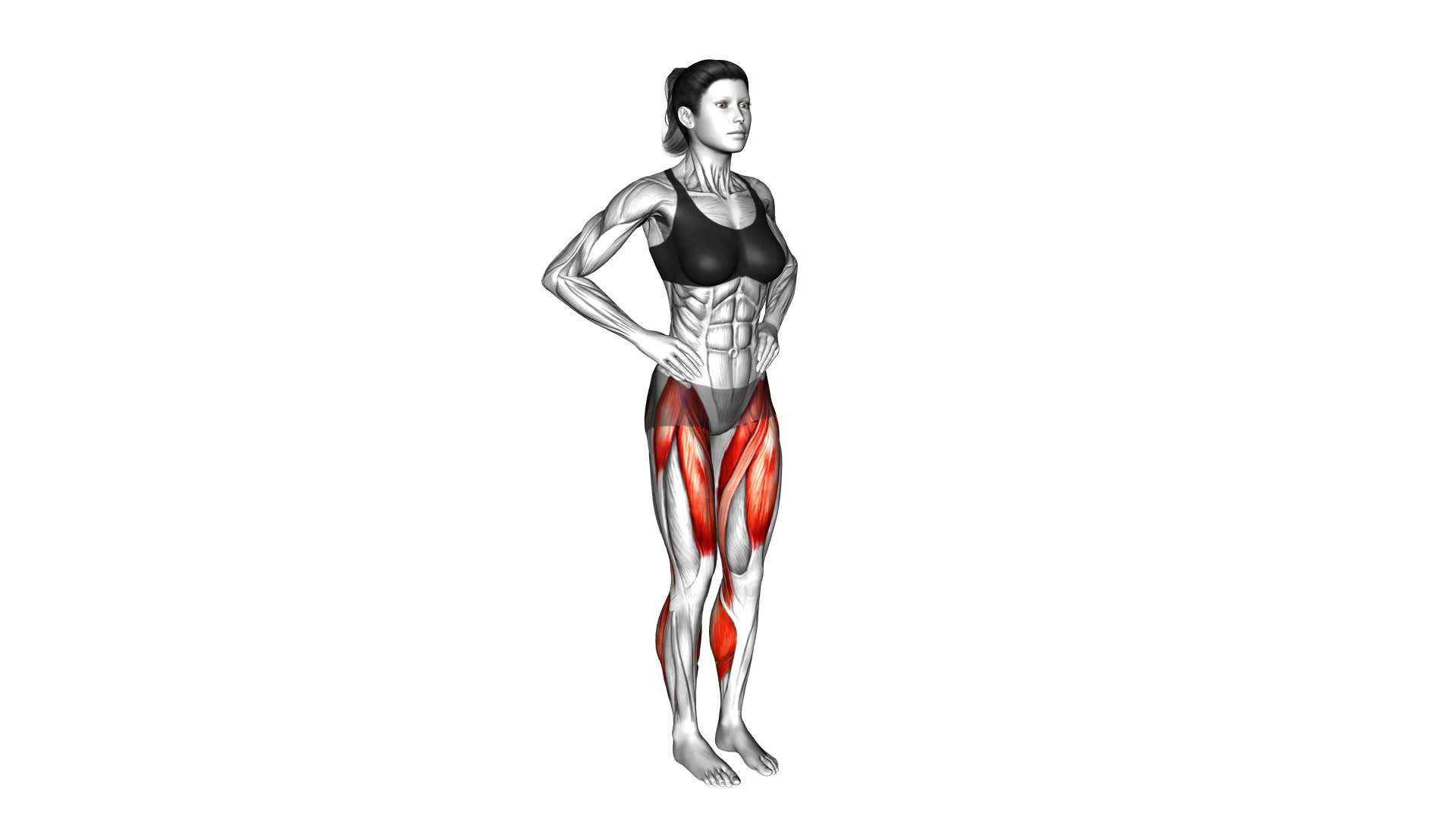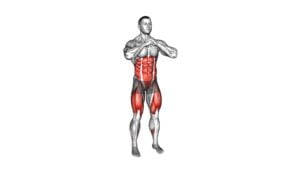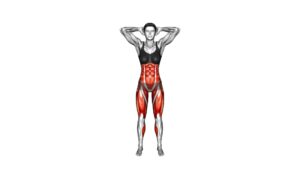Standing Knee Raise (female) – Video Exercise Guide & Tips

Looking to strengthen your core and improve your balance? The standing knee raise is a great exercise for you!
Watch This Exercise Video
In this video exercise guide, we'll take you through the proper form and variations of the standing knee raise. With these tips, you'll be able to maximize your results and achieve your fitness goals.
So grab your workout gear and get ready to feel the burn!
Key Takeaways
- Improved focus and concentration
- Targets lower body muscles
- Engages hip flexors, quadriceps, and gluteal muscles
- Works abdominal muscles for stabilization
Benefits of Standing Knee Raise
You can experience numerous benefits from incorporating the standing knee raise exercise into your workout routine. Not only does this exercise target your lower body muscles, but it also offers mental benefits and enhances muscle activation.
One of the mental benefits of the standing knee raise is improved focus and concentration. As you perform this exercise, you need to maintain a balanced posture and engage your core muscles. This requires mental focus and concentration, which can help sharpen your mind and increase your overall cognitive abilities.
Additionally, the standing knee raise activates multiple muscle groups in your lower body. When you lift your knee towards your chest, you engage your hip flexors, quadriceps, and gluteal muscles. This exercise also works your abdominal muscles as they help stabilize your body during the movement. By incorporating the standing knee raise into your workout routine, you can effectively target these muscles and improve their strength and endurance.
Equipment Needed for Standing Knee Raise
To perform the standing knee raise, you'll need a stability ball or a chair. These items will provide support and stability while you perform the exercise.
In addition to the stability ball or chair, there are a few other items that are important for the standing knee raise:
- Proper footwear: It's essential to wear the right shoes when doing the standing knee raise. Choose a pair of athletic shoes that provide good support and cushioning. This will help maintain proper alignment and reduce the risk of injury.
- Comfortable clothing: Wear clothing that allows for a full range of motion and doesn't restrict your movements. Opt for breathable and stretchable fabrics that will keep you comfortable throughout the exercise.
- Water bottle: Staying hydrated during your workout is crucial. Have a water bottle nearby, so you can take sips of water as needed.
- Exercise mat: If you're performing the standing knee raise on a hard surface, it may be beneficial to use an exercise mat for added comfort and cushioning.
- Timer or stopwatch: To track your progress and ensure that you're performing the exercise for the desired duration, have a timer or stopwatch handy.
Now that you have the necessary equipment, let's move on to the next section and discuss the common mistakes to avoid during the standing knee raise.
Proper Form for Standing Knee Raise
To ensure proper form during the standing knee raise, focus on engaging your core and maintaining a stable posture throughout the exercise. This will help you target the right muscles and prevent any potential injuries. One common mistake people make is swinging their leg instead of lifting it. Remember to control the movement and raise your knee towards your chest in a slow and controlled manner. Another mistake is leaning forward or backward. Keep your spine aligned and your torso upright throughout the exercise.
When performing the standing knee raise, you primarily work your hip flexors, which are the muscles responsible for lifting your thigh towards your chest. Additionally, your abdominal muscles, particularly the rectus abdominis and the obliques, are engaged to stabilize your torso.
To get the most out of this exercise, make sure to maintain proper form and avoid these common mistakes. By focusing on engaging your core and maintaining a stable posture, you'll effectively target the desired muscles and achieve optimal results.
Variations of Standing Knee Raise
Explore different variations of the standing knee raise to challenge your muscles and add variety to your workout routine. By incorporating different techniques, you can target specific muscle groups and enhance muscle activation.
Here are five variations to try:
- Single-leg standing knee raise: Instead of raising both knees at the same time, focus on one leg at a time. This variation increases the intensity and forces each leg to work independently.
- Standing knee raise with dumbbells: Hold a pair of dumbbells in your hands while performing the exercise. The added weight increases resistance and engages your upper body muscles as well.
- Side-to-side standing knee raise: Instead of lifting your knees straight up, lift them out to the sides. This variation targets your hip abductors and provides a different type of challenge.
- Standing knee raise with a twist: As you raise your knees, twist your torso to the side. This movement engages your obliques and adds a rotational component to the exercise.
- Standing knee raise with a medicine ball: Hold a medicine ball between your hands and lift your knees while maintaining balance. This variation challenges your core stability and coordination.
Tips for Maximizing Results With Standing Knee Raise
Maximize your results with the standing knee raise by incorporating these tips into your workout routine. To get the most out of this exercise, it's important to avoid common mistakes and target the right muscle groups.
One common mistake is using momentum to lift your leg instead of relying on your core strength. This can reduce the effectiveness of the exercise and put strain on your lower back. Instead, focus on engaging your abdominal muscles and using controlled movements to lift your leg.
Another mistake is neglecting proper form. Make sure to keep your upper body upright and your shoulders relaxed throughout the exercise. Avoid leaning forward or hunching your back, as this can lead to poor posture and potential injuries.
To target the right muscle groups, concentrate on engaging your hip flexors and abdominal muscles. As you lift your leg, squeeze your abs and focus on bringing your knee as high as possible towards your chest. This will help to strengthen your core and improve your balance.
Incorporating these tips into your standing knee raise routine will help you maximize your results. By avoiding common mistakes and targeting the right muscle groups, you can enhance the effectiveness of this exercise and achieve your fitness goals more efficiently.
Frequently Asked Questions
How Many Calories Can Be Burned by Performing the Standing Knee Raise Exercise?
Performing the standing knee raise exercise can help you burn calories and strengthen your core muscles. By engaging your abdominal muscles and lifting your knees towards your chest, you activate your body's calorie-burning process. The exact number of calories burned depends on various factors such as your weight, intensity, and duration of the exercise.
To maximize calorie burn, you can modify the knee raise exercise by adding weights or performing it at a faster pace.
Can Standing Knee Raise Exercise Help in Strengthening the Core Muscles?
Yes, the standing knee raise exercise can indeed help in strengthening your core muscles. By lifting your knee towards your chest while standing, you engage your abdominal muscles, including the rectus abdominis and obliques.
This exercise also works your hip flexors and improves your balance.
However, if you're looking for alternative core exercises, you can try planks, Russian twists, or bicycle crunches. These exercises target your core muscles and can provide additional benefits to your overall fitness routine.
Is It Safe to Perform Standing Knee Raise Exercise if I Have a Previous Knee Injury?
When you have a previous knee injury, it's important to take precautions before performing the standing knee raise exercise. Consult with your healthcare provider or a professional trainer to determine if it's safe for you.
They can provide guidance on modifications or alternative knee-friendly exercises that can help strengthen your core without putting excessive strain on your injured knee.
Always prioritize your safety and listen to your body's signals during any workout.
How Often Should I Include the Standing Knee Raise Exercise in My Workout Routine?
To determine the ideal workout frequency for including the standing knee raise exercise in your routine, consider your fitness goals and overall exercise program.
As a general guideline, aim to perform this exercise 2-3 times a week, allowing for adequate rest and recovery between sessions.
Additionally, you can vary the exercise by incorporating different variations, such as holding weights or performing the exercise on a stability ball, to challenge different muscle groups and prevent plateauing.
Can the Standing Knee Raise Exercise Be Modified for Beginners or Individuals With Limited Mobility?
Yes, the standing knee raise exercise can definitely be modified for beginners or individuals with limited mobility. There are several modified variations you can try, such as using a chair for support or reducing the range of motion. These modifications allow you to still engage your core and leg muscles without putting too much strain on your joints.
This exercise also has great benefits for seniors, as it helps improve balance, stability, and overall lower body strength.
Conclusion
In conclusion, the standing knee raise is a beneficial exercise for women that targets the core, hip flexors, and thigh muscles. By lifting the knee towards the chest while maintaining proper form, this exercise helps improve balance, stability, and overall lower body strength.
Remember to start with a comfortable range of motion and gradually increase intensity as you progress. Incorporate variations and follow the tips provided to maximize your results with the standing knee raise.
Keep up the great work!

Author
Years ago, the spark of my life’s passion ignited in my mind the moment I stepped into the local gym for the first time. The inaugural bead of perspiration, the initial endeavor, the very first surge of endorphins, and a sense of pride that washed over me post-workout marked the beginning of my deep-seated interest in strength sports, fitness, and sports nutrition. This very curiosity blossomed rapidly into a profound fascination, propelling me to earn a Master’s degree in Physical Education from the Academy of Physical Education in Krakow, followed by a Sports Manager diploma from the Jagiellonian University. My journey of growth led me to gain more specialized qualifications, such as being a certified personal trainer with a focus on sports dietetics, a lifeguard, and an instructor for wellness and corrective gymnastics. Theoretical knowledge paired seamlessly with practical experience, reinforcing my belief that the transformation of individuals under my guidance was also a reflection of my personal growth. This belief holds true even today. Each day, I strive to push the boundaries and explore new realms. These realms gently elevate me to greater heights. The unique combination of passion for my field and the continuous quest for growth fuels my drive to break new ground.







